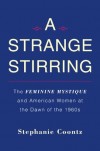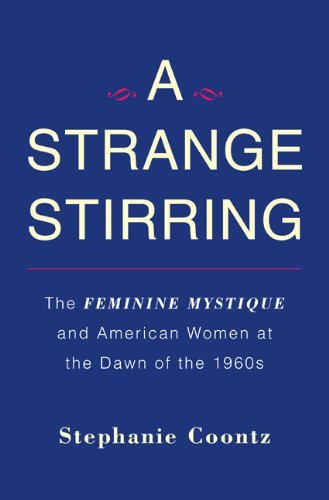 The Plot
The Plot
The Feminine Mystique by Betty Friedan was published in 1963, at a time when the prevailing attitude in the U.S. was that women were ideally suited to homemaking and raising a family — and nothing else. The years that followed its publication saw the rise of the women’s movement, which managed for the most part to overturn this view and provide American women with a more level playing field in home, work and school. But how much did The Feminine Mystique really have to do with what came after? Stephanie Coontz examines the book’s trajectory and tries to trace its influence.
My Thoughts
I don’t exactly remember where I first heard of the book The Feminine Mystique. It may have been an episode of Quantum Leap, though I feel as if I’d heard of it before then. It doesn’t seem very likely to have been at school, where no social studies class ever managed to get much further than the (U.S.) Civil War and vast quantities of time was always spent on the pilgrims and pre-Revolution colonies. In any case, I had heard of it at some point prior to the summer after my sophomore year of high school. That summer I was attending a science program at UNH, and after I spent the first part of the summer plowing through Anna Karenina, I ventured to the university bookstore in search of something else to make me feel scholarly and well-read. The Feminine Mystique fit the bill admirably: it was paperback, it was fat, and I was curious to know what sort of amazing revelations it held.
Since that summer, I’ve read the book a number of times, each time finding something different. Every time there’s disbelief over the fact that such Victorian sounding ideas about the womanly sphere persisted until so recently. Once, I was shocked by Friedan’s comments about homosexuality, something which colored the entire book for me. The next time I read it, I had convinced myself there was an entire chapter ranting about how the Feminine Mystique was turning boys gay, and I was surprised to find the material I’d thought so pervasive was probably comprised of less than 5 pages all total. During my most recent reading, a couple of weeks ago, I began to wonder if Matthew Weiner had pulled the character of Betty Draper straight from its pages. But throughout every reading there has been the feeling that while I might have been 30 or 40 or 50 years removed from the time period Friedan was writing about, if I lived then, I, a somewhat over-educated middle-class white woman, would be her target audience. It has always made me think about what my life would have been like if I’d been born in 1936 instead of 1976.
So I was intrigued when I heard about A Strange Stirring, an attempt to examine the book in context: where it was successful and where it might have failed. And whether it really deserved to be hailed as a book that began a revolution.
Though I’m by no means a Stephanie Coontz superfan, a few years ago I did read The Way We Never Were and found it quite eye opening. But then, it’s never been any secret that politicians and pundits are happy to pick and choose from history to better illustrate their dogmatic points, whether or not they hold up on closer examination. In any case, she continues to publish works on the history of families and marriage in the United States — something which as far as I’m concerned, makes her eminently qualified to make this attempt to examine more closely The Feminine Mystique and its associated mythos.
Coontz begins by outlining the female facts of life in the 1960s: though people are inclined to look back upon the post-WWII era fondly, the fact is the legal system as regards to women was very barely advanced from the post-Civil War era. Many states legally defined the husband as the head of the wife (a status which I find hard to differentiate from ‘owner’ since it seems to have given him rights almost equivalent); possession of a vagina was actually considered a legal disability in setting up a business — many states required women to go before a judge before they could operate their own business; women had a very hard time opening bank accounts and obtaining credit; women could be denied housing without a male to co-sign the lease; some states made it illegal for women to wear men’s clothing; birth control was not a legal right, even for married couples; women often had no right to any of their husband’s assets in the event of a divorce, though a husband could forbid his wife from taking a job. Interestingly enough, Friedan herself does not dwell on any of these legal horror shows, and I guess I never had imagined it was really still this bad in the U.S. so recently. It’s barely two steps removed from some of the more oppressive regimes in the world today. In light of this, the tone Friedan took (which simultaneously blamed women for their own predicament and exhorted them to feel empowered enough to change their lives) is all the more astonishing. Far from being the man-bashing tome many have made it out to be, The Feminine Mystique is actually fairly silent on the question of what to do about the menfolk, and it actually calls for very little legal change.
As Coontz also correctly points out, there were significant populations of the U.S. who couldn’t see themselves and their struggles in Friedan’s descriptions. The self-deprecating twitter hashtag #firstworldproblem could definitely be appended to pretty much every sentence. But just because it’s a problem mostly for an affluent segment doesn’t negate the fact that it was a problem. And The Feminine Mystique managed to reach a group of women who might otherwise have been slow to join the push for women’s empowerment; it shone a light on their secret thoughts and concerns and made them far more receptive to the idea that even they, in their large houses and with their much-loved children, might be in need of and deserving of change. This is important: anyone who has had their genuine issues belittled by having someone else’s more horrific situation thrown in their face knows how easy it is to generate guilt for complaining when ‘people are starving in Africa’ or ‘there are homeless people living on the streets’ or ‘women in another country aren’t even allowed to go to school’.
But for the women who saw themselves in Friedan’s book, it was a revelation; a relief to know they weren’t alone. And even though the book was not groundbreaking — Coontz traces its origins through several scholarly works published in the decade prior — it made an impact because it was written in a readable style, it drove home its points well, and it was marketed not as an academic treatise but directly to the public. Excerpts appeared in the most popular women’s magazines. The target demographic was made very aware of the book, and thus its message was able to penetrate the public consciousness in a way that other books had not. Did it single-handedly start the women’s movement? No. But did it get the word out and get people talking about what was going wrong with American women? Yes. And in that way, its contribution, though not as much as the myths might claim, was hardly unimportant.
In Short
Somehow, prior to reading this book, I had heard that Coontz ‘blasts’ Friedan for, among other sins, leaving working-class and minority women mostly out of The Feminine Mystique. “Of course she did,” I grumbled to myself. “The book’s focus was suburban housewives, not women in general.” So I went into A Strange Stirring with a wary eye. I needn’t have worried, however, as Coontz is not a pundit but a scholar, and she has no agenda here: she fully acknowledges the narrow focus of The Feminine Mystique while she simultaneously examines the reactions of women outside the target audience. She paints a fuller historical picture of Friedan’s background, the state of U.S. women in general, and the state of the women’s movement at the time The Feminine Mystique was published, allowing the reader to see why the book was not a thunderclap appearing out of nowhere, but nonetheless an important book published at the right and needed time.


Among other things she mentioned about the legal status of women was that girls could marry a lot younger than boys. And that’s still true. And now they’ve gone even further.
In NH, a girl only has to be 13 to marry a boy. The boy has to be 14. But if either of them want to marry the same sex, they have to be 18.
It just boggles my mind that they could rewrite the marriage law and think that age thing wasn’t weird and wrong! And then to compound the problem. Because heaven forbid a girl of 13 marry another girl of 13.